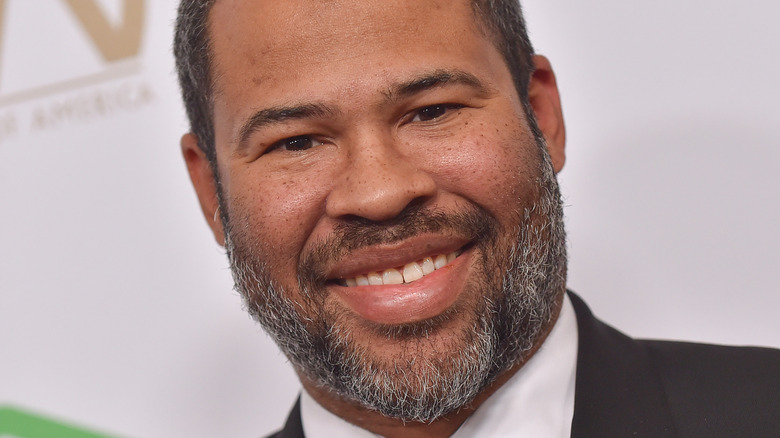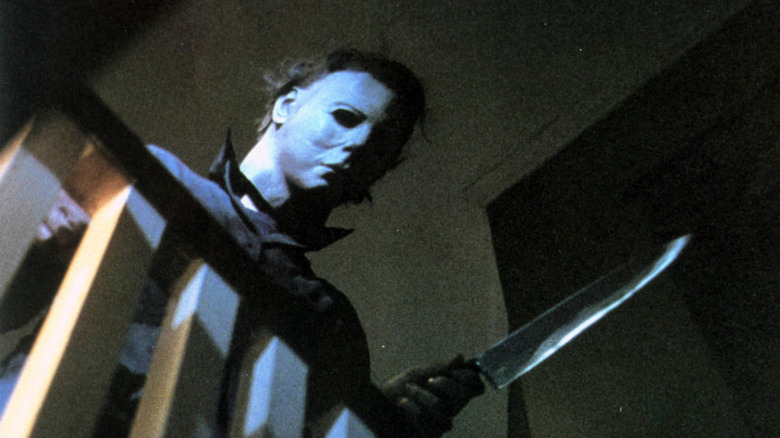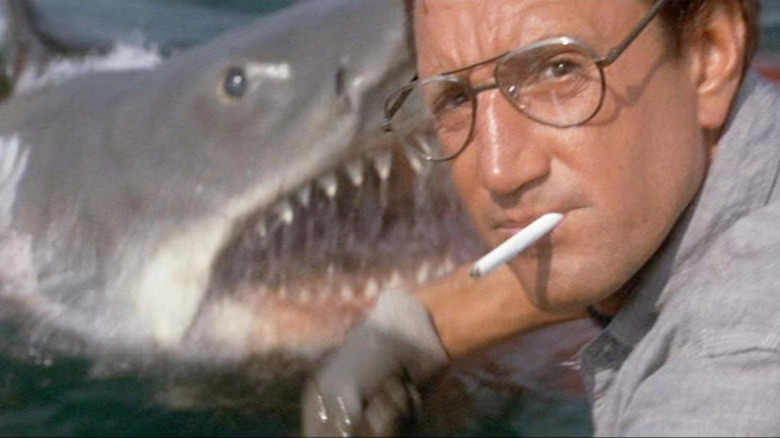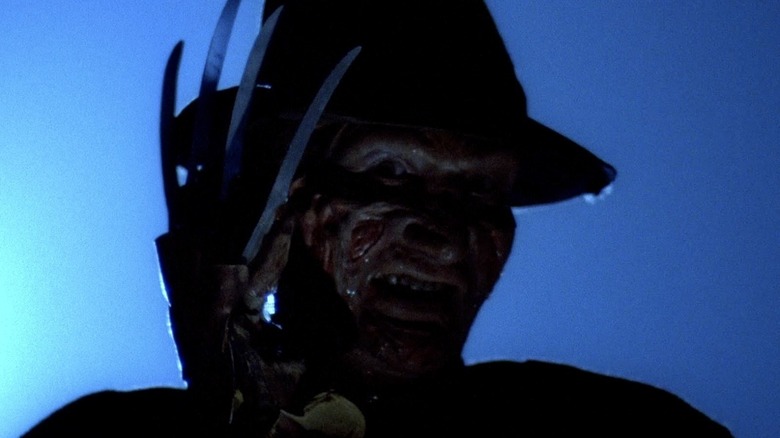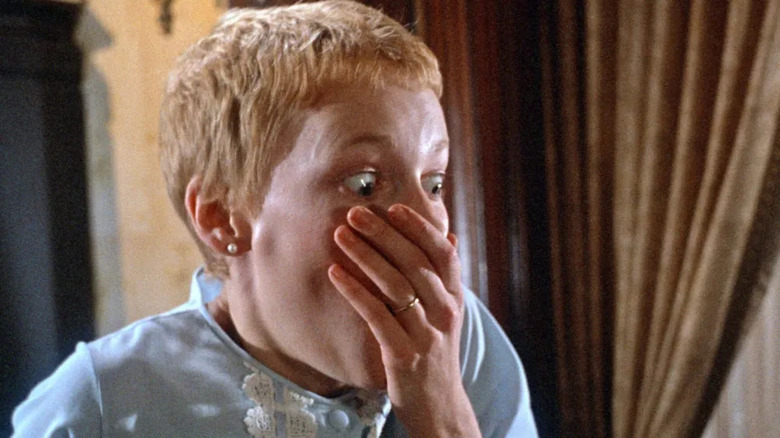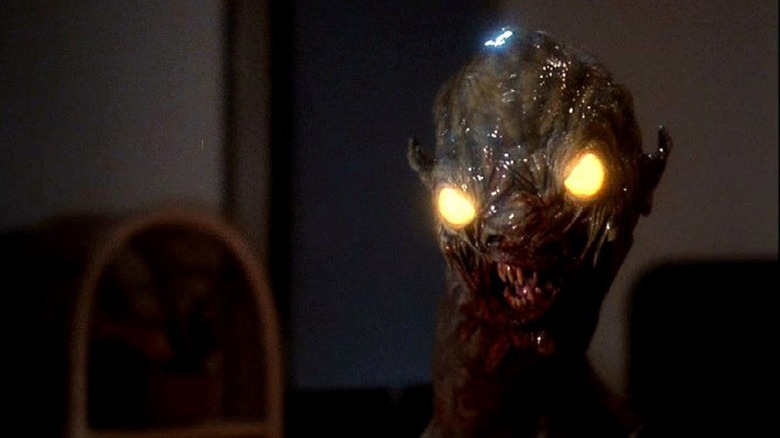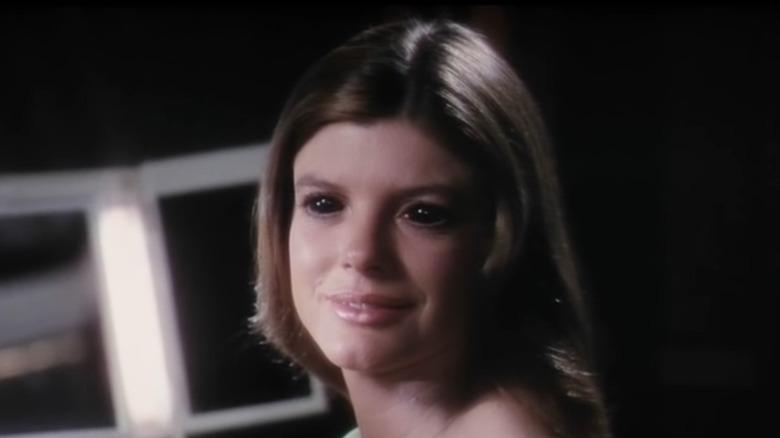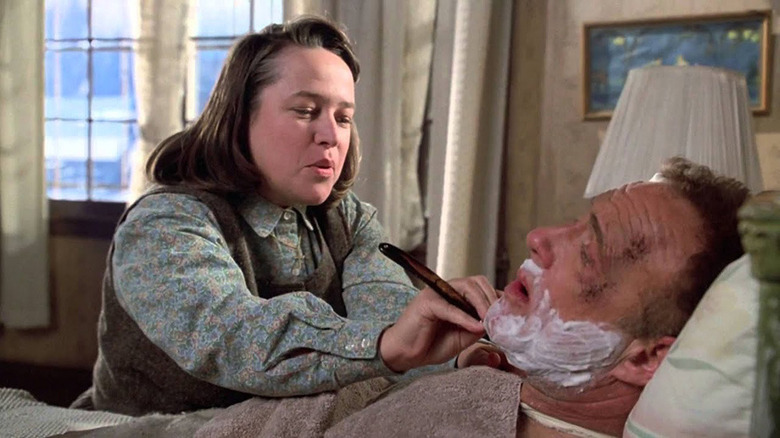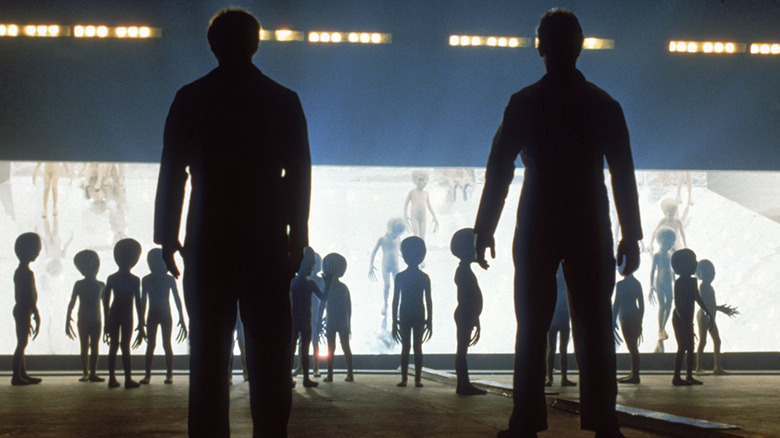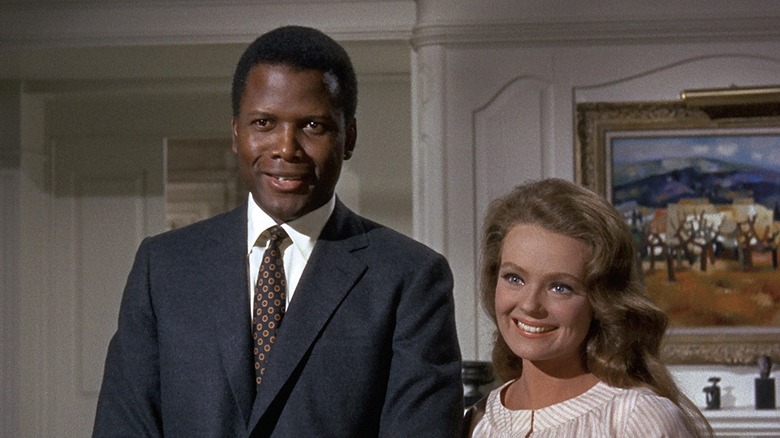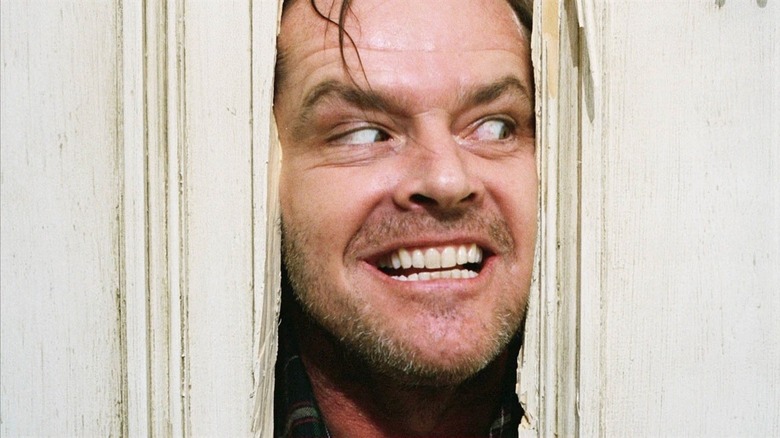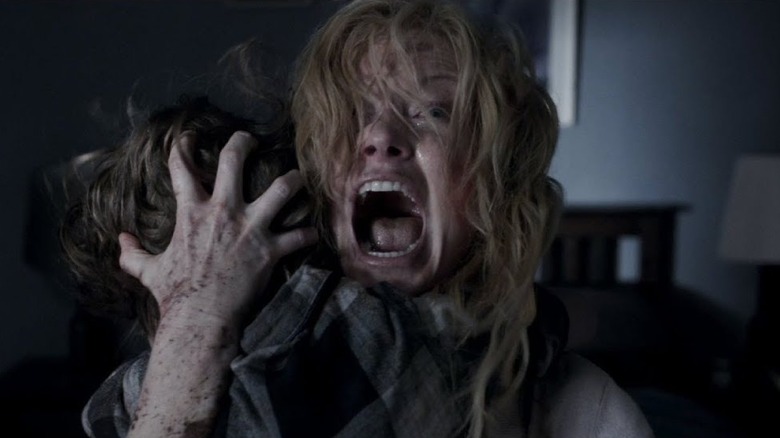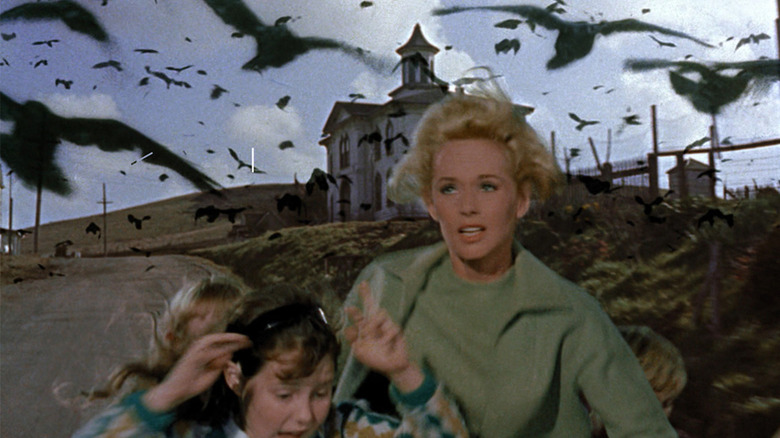Movies That Influenced Jordan Peele
Jordan Peele has become synonymous with the horror genre since his directorial debut with "Get Out" in 2016. Both audiences and critics have been impressed, terrified and mystified by Peele's ever growing film catalog that includes the likes of "Us" and "Nope." Peele has never shied away from discussing the films that have affected his work. In fact, all of his movies are peppered with stylistic homages and easter eggs referencing other films.
Peele has been open about the movies that have impacted his filmmaking and screenwriting processes, whether it's something that terrified him as a child and made him love horror or it's a film that he saw as an adult that stuck with him for one reason or another. These movies run the gamut from big budget summer blockbusters to modern independent horror to classic dramas. Presented here are a few films that, for one reason or another, have influenced Jordan Peele and his filmmaking.
Halloween
Jordan Peele has not held back about his respect for "Halloween" director John Carpenter. When one Twitter user declared that Peele is the best horror director of all time, Peele emphatically responded: "I love your enthusiasm but, I will just not tolerate any John Carpenter slander!!!" (via Twitter). In an interview with The Wall Street Journal, Peele explained why "Halloween" villain Michael Myers is the scariest of all: "He's not even evil; he's just curious. You know you can't talk him out of whatever it is he wants to do."
"Halloween" follows Laurie Strode (Jamie Lee Curtis), a babysitter in the small town of Haddonfield, who finds herself in the crosshairs of serial killer Michael Myers (Nick Castle). The silent stalker Myers — donning a blue jumpsuit and a white Captain Kirk mask — quickly turns Laurie and all of her friends' Halloween night into a nightmare.
The '70s saw the rise of the summer blockbuster thanks to big budget and visual effect-heavy movies like "Jaws" and "Star Wars" (via Celebrating Cinema). 1978's "Halloween," on the other hand, is a low budget horror film that relies on its camera work and chilling musical score to achieve its scares.
This stylistic approach clearly affected Peele, who ranked his favorite horror films in a video for Fear: The Home of Horror, and noted that "Halloween" is "elegant, it's terrifying." It's clear where Carpenter's slasher classic has influenced Peele in his slasher-leaning "Us." The Tethered wear jumpsuits similar to Michael Myers' (albeit a more sinister crimson color), and they are also primordial in their killing like Carpenter's influential masked killer.
Jaws
It's the film that made an entire generation afraid to go for a swim and one that Jordan Peele holds in high regard. In Steven Spielberg's "Jaws," the quiet seaside town of Amity Island finds itself under attack from a vicious man-eating shark. With bodies piling up and the mayor unwilling to close the beaches in the middle of the high summer season, police chief Martin Brody (Roy Scheider) must take action. Aided by oceanographer Matt Hooper (Richard Dreyfuss) and fisherman Quint (Robert Shaw), Brody sets off on sea-bound adventure to neutralize the terror plaguing his town.
From its oceanic cinematography to its stellar soundtrack, "Jaws" is regarded by many as an unparalleled classic. Peele certainly thinks so, as in a video for Fear: The Home of Horror, he declared that "Jaws" is "debatably, the greatest movie of any genre of all time." He's definitely taken a few cues from Spielberg's classic, explaining to USA Today: "The most beautiful revelation with 'Jaws' was the audience's imagination is far more powerful than what you show them. ... It changes the way we think of how to tell the story of a monster."
Peele has paid tribute to "Jaws" in overt visual ways, such as by having Jason (Evan Alex) wear a "Jaws" t-shirt in "Us" (via Insider). Meanwhile, "Nope" includes thematic connections to "Jaws" as it similarly centers around a ragtag trio, who use various methods to contend with a monstrous creature. And like Spielberg's film, viewers don't get a full look at the mysterious monster until the movie's second half.
A Nightmare on Elm Street
The power of horror can come from mining fear from the most abstract or surreal of spaces, such as dreams and nightmares. Nowhere is this more prevalent than in Wes Craven's 1984 classic "A Nightmare on Elm Street," the film that made legions of people afraid to fall asleep.
Teenager Nancy Thompson (Heather Langenkamp) and her friends start getting stalked in their dreams by a disturbing figure with a fedora and claws. They soon realize that this monstrous figure is Freddy Krueger, a child predator who was burned alive by the parents of their town as punishment for his crimes. Nancy, armed with coffee and her wits, must defeat Krueger so that she can live to see the sunrise.
Peele picked "A Nightmare on Elm Street" as his favorite horror movie of all time in a March Madness style bracket for Fear: The Home of Horror, noting that Freddy Krueger is "a special kind of boogeyman that I don't think we've come close to since." While on The Tonight Show with Jimmy Fallon, Peele elaborated on this power of Freddy Krueger, describing the feeling he had when he first came up with a scary story to tell his classmates: "I just felt like, 'man, I am Freddy Krueger. ... I can be the monster. ... I can give the night terrors." Additionally, Peele told The Wall Street Journal that Charles Bernstein's score for "A Nightmare on Elm Street" is his favorite horror soundtrack.
Rosemary's Baby
Sometimes a horror film transcends the genre to become beloved by mainstream audiences and critics as well. "Rosemary's Baby" is one of those films and given its immense impact, it isn't hard to see why many – including Jordan Peele – hold it in such high regard. In fact, Peele loves the movie so much that he did a full (and very accurate) recreation of it via emojis on Twitter.
Guy Woodhouse (John Cassavetes) and his wife Rosemary (Mia Farrow) have just moved into a sizable New York apartment. However, it soon becomes clear to Rosemary that their new neighbors, the Castevets, aren't who they appear to be. Her suspicions are confirmed when the Castevets pay her a strange visit and Rosemary becomes pregnant without any concrete memory of how. She soon discovers that her conception may have ties to the supernatural and the Devil himself.
"Rosemary's Baby" is a disturbing gem if there ever was one, as it possesses both surreal dreamlike visuals and horrific moral implications. The film is adapted from the eponymous novel by Ira Levin, who also wrote "The Stepford Wives." During an interview with UCLA, Peele recounted his appreciation for Ira Levin's writing technique "of inching us towards this inevitable horrific reveal," which is an influence that's clearly seen in the slow reveal of a twist ending in "Get Out."
Speaking to Forbes, Peele confirmed that both "Rosemary's Baby" and "The Stepford Wives" were inspirations for "Get Out" because "as those movies are developing we reveal more and more about this sort of awful direction it's heading."
C.H.U.D
Cannibalistic Humanoid Underground Dwellers, or "C.H.U.D" for short, is a 1984 science fiction horror film directed by Douglas Cheek. The film follows George Cooper (John Heard), who teams up with A.J. "The Reverend" Shepherd (Daniel Stern) to investigate a series of disappearances in NYC. Believing the whole thing to be a part of a government cover-up, the duo discover the horrific truth that exists right under their feet: a ravenous legion of cannibalistic humanoid underground dwellers (or C.H.U.Ds) live in the sewers and these creatures are themselves mutated humans.
Thematically and narratively, the film centers around the idea of those "underneath" society rising up to enact some form of revenge on those above them. Any eagle eyed fan of Peele's work will notice his affinity for slotting easter eggs within his film and television projects. For example, "Us" opens with an old commercial for Hands Across America.
Alongside the television playing the advertisement are shelves holding various books and video tapes belonging to Adelaide's family, including a copy of "C.H.U.D.," which provides some covert foreshadowing for horror fans in the know (via Vanity Fair). In an interview with Polygon, Peele noted that his first girlfriend's father directed "C.H.U.D.," so the reference is a personal one as well.
The Stepford Wives
While on the press tour for his inaugural horror release of "Get Out," Jordan Peele noted two key influences on his work in an interview with UCLA: Ira Levin's novels "Rosemary's Baby" and "The Stepford Wives," both of which were adapted to film.
The 1975 film "The Stepford Wives" follows couple Joanna (Katharine Ross) and Walter (Peter Masterson), who relocate to Stepford, Connecticut with their two daughters. Things seem pleasant enough until Joanna starts befriending the other wives of Stepford and becomes increasingly aware of their eccentricities such as their lack of ambition or identity. The more Joanna gets to know them, the more she starts to feel that these women are mindless, subservient, and perfect housewives. She soon starts to suspect that something is very wrong in Stepford.
"The Stepford Wives" presents a chilling story about antiquated societal molds and suburban brainwashing — both handled with a masterfully disturbing touch. Speaking to UCLA, Peele described how Levin builds worlds so subtly that the protagonist can't tell if something sinister is really happening or if it is "garden variety average social weirdness."
This is certainly the case in "The Stepford Wives," as Joanna starts to question her reality. This balance of social commentary and high concept science fiction-horror is clearly on display in "Get Out," as Chris wonders if he's dealing with the type of racism he's encountered before or something even more sinister.
Misery
"Misery" comes straight from the wonderfully deranged mind of Stephen King, who first published the novel in 1987. The great Rob Reiner adapted it for the screen in 1991 and the film features one of cinema's most terrifying performances ever courtesy of Kathy Bates.
Paul Sheldon (James Caan) is an author, who's famous for a series of books about a protagonist named Misery. After finishing his latest manuscript, Paul gets into a brutal car accident. He wakes up to find himself immobilized from his injuries, in the care of former nurse Annie Wilkes (Kathy Bates). Annie is a self-professed super fan of Paul's books, so she's very accommodating towards his patient ... until she discovers that he's killed off Misery in his most recent manuscript. Now, held captive by Annie, Paul is forced to write a new book tailor-made to her excruciatingly high standards.
From Bates' haunting performance to the isolating winter atmosphere, "Misery" is a riveting watch from start to finish. Peele thinks highly of the film, describing its influence to USA Today: "it's also a movie where the acting and the performance and the script and the dialogue is where the fear in the movie lies. I love that kind of technique." He also noted that "Misery" stands out because "the unlikely villain turns out to be the scariest," a concept that he played with in "Get Out."
Close Encounters of the Third Kind
Given his appreciation for "Jaws," it should be no surprise that Jordan Peele has a great affection for the work of Steven Spielberg. During an interview with BackstageOL, Peele revealed that his film "Nope" was influenced by Spielberg's alien classics, "E.T." and "Close Encounters of the Third Kind," particularly the latter.
"Close Encounters of the Third Kind" centers around Roy Neary (Richard Dreyfuss), a local electrician who has his own close encounter and becomes obsessed with uncovering the truth. It soon becomes clear that Roy is far from the only one who has encountered a UFO and eventually, a sizable mothership makes first contact with humanity in grand Spielberg fashion.
"Close Encounters of the Third Kind" presents a very down-to-earth narrative regarding a very interstellar concept, complete with jaw-dropping special effects. Speaking to Backstage OL, Peele noted that the film is "such an awe-inspiring cinematic feat and I think the ambition with a flying saucer film and taking that on, [Spielberg] brought the appropriate ambition to it and so I felt a sort of responsibility to take on that ambition and do things in my style."
Guess Who's Coming to Dinner
Stanley Kramer's "Guess Who's Coming to Dinner" was a game changer back when it was released in 1967 due to its portrayal of an interracial relationship. Joanna (Katharine Houghton) brings her African American fiancé John (Sidney Poitier) home to meet her parents, Christina (Katharine Hepburn) and Matt (Spencer Tracy). Joanna's parents become flummoxed over their daughter's engagement, and both of them adjust to it at different speeds.
"Guess Who's Coming to Dinner" never shies away from addressing the often uncomfortable conversations that come from a situation like this, as both Christina and Matt — as well as John's parents — must confront their prejudices and self-denial head-on.
During an appearance on "The Q&A with Jeff Goldsmith," Peele noted his appreciation for the film and its influence on "Get Out." He stated that "one of the reasons that film was so effective in its discussion with race is because it started with a situation that was universal." He further elaborated, saying, "Take the race out of it, everybody can relate to the fear of meeting your potential in laws for the first time."
The Shining
From film students to film critics, the work of director Stanley Kubrick has been praised, lambasted, and picked apart piece-by-piece. The man helped to revolutionize the science-fiction genre with "2001: A Space Odyssey," and brilliantly satirized war with "Dr. Strangelove." However, one of his most memorable cinematic contributions is his adaptation of Stephen King's "The Shining."
The film follows the Torrance family — Jack (Jack Nicholson), Wendy (Shelley Duvall), and their son Danny (Danny Lloyd). Jack has taken a job of overseeing the Overlook Hotel while it's closed during the winter season. Once settled in at their lavish new accommodations, things begin to unravel, as the hotel is harboring supernatural and malevolent forces. It's not long before Jack succumbs to the hotel's manipulations and begins menacing his family.
It's very clear that Jordan Peele loves both Stanley Kubrick and his version of "The Shining" — the man's wardrobe is evidence enough. Peele also confirmed to Vanity Fair that there's a direct homage to "The Shining" in an easter egg that's included in "Get Out." While Rod the TSA Agent (Lil Rel Howery) is working his airline job, you can hear an announcement for flight 237, which refers to the sinister room 237 at the heart of many events in the Overlook Hotel.
Peele also spoke to USA Today about what makes "The Shining" so influential, saying it has "an attention to almost a subconscious level of perception of something creepy going on. It's just unsettling and I don't think anyone's really done a horror movie that well since."
The Babadook
Jennifer Kent's "The Babadook" is one of the defining horror films of the 2010s. Amelia (Essie Davis) is a single mom living with her young son Sam (Noah Wiseman). Amelia harbors passive aggressive feelings towards Sam, whose birth was semi-responsible for her husband's death. A mysterious pop-up book appears in Sam's room, telling the story of a creature named "Mister Babadook." Sam becomes terrified of the character and, soon enough, Ameila begins to feel the entity's presence in their home.
While on one hand, "The Babadook" is about this "monster," at its heart, it's a metaphor for grief. This approach to storytelling struck a chord with Peele, who described "The Babadook" in a video for Fear: The Home of Horror: "It was just a movie about something different than what it was about and it scared the pants off of me."
In an interview with Mother Jones, Peele explained his belief about the function of horror: "With a horror movie, you're making a metaphor. You're making a personalized nightmare for the protagonist." It's no surprise that he's a fan of "The Babadook" and the way it integrates reality and emotions with horror, as the film is heavily predicated on Amelia's personal traumas and fears.
It's clear that Peele also takes this approach with his films, which are never about what they seem to be about, much like "The Babadook." He's such a fan of Kent's modern classic that he tweeted the entire plot of "The Babadook" using emojis and included it on his list of horror movies for Lupita Nyong'o to watch to prepare for her role in "Us" (via Entertainment Weekly).
The Birds
Peele has spoken many times about his appreciation for the work of Alfred Hitchcock. In an interview with E! Insider, Peele noted that he took inspiration for the Bay Area setting of "Us" directly from "The Birds," which is set in San Francisco. He also included "The Birds" as required viewing for Lupita Nyong'o to watch before filming "Us" (via Esquire).
In "The Birds," Melanie Daniels (Tippi Hedren in her on-screen debut) meets an attractive lawyer, Mitch Brenner (Rod Taylor). She decides to deliver some love birds to him as a surprise, and goes to visit him on his family farm in Bodega Bay. There, she's attacked by a seagull. Soon enough, more and more bird-related attacks begin to pop up around the area and people start dying from these suddenly aggressive birds.
As absurd a concept of killer birds may be, Hitchcock takes his film to its most logical and disturbing conclusion, which results in some of horror's most haunting images. "Us" similarly takes a society-ending approach, and it's no wonder that Peele listed "The Birds" as one of his favorite horror films in an interview with Forbes.
